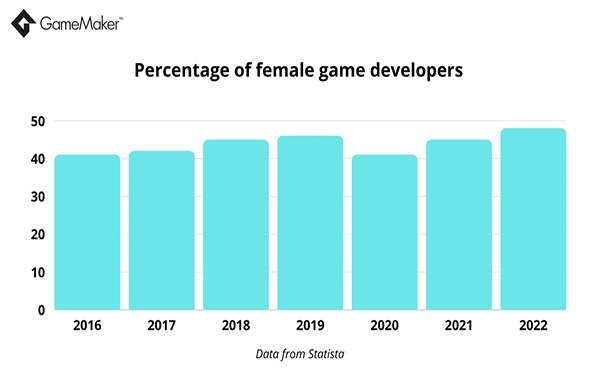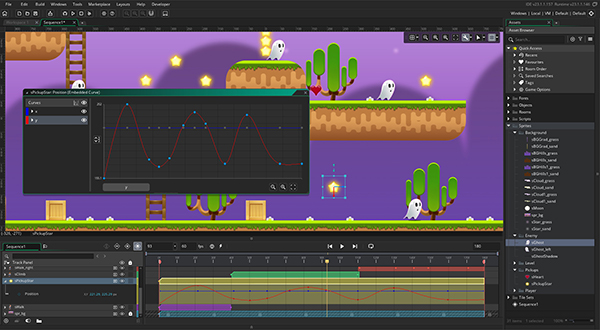We’ve all had to smile through at least one conversation with an elderly relative as they bemoan the hours kids dedicate to video games.
‘Back in my day, all I had was mud and my Flossie Flirt Doll’, they say. ‘Yes Grandma,’ we sigh.
These days, we know that video games can actually have a positive effect on kids: they can teach teamwork and problem-solving skills, increase their self-confidence, and improve their hand-eye coordination.
But that’s just playing games: what about making games? Does educating students through game design offer similar benefits, and if it does, what will Grandma say when she finds out?
This article includes:
- Increase classroom engagement
- Diversity and inclusivity
- Teaching humanities subjects
- Teaching STEM subjects
- Improves problem-solving skills
- Managing feedback and failure
- Promote creativity, expression, and individuality
- Develop social intelligence skills
- Strengthening teacher/student bond
- Bring game design to your classroom with GameMaker
Increase classroom engagement
They said they’d rot our brains, that they’d make us more violent, that they’d never catch on - but in 2023, video games are the most popular form of entertainment in the world.
In fact, 66% of Americans say they play games regularly, and 93% of children in the UK say they play games to relax and socialise with their friends.
It was only natural that teachers would explore the effectiveness of video games in the classroom, and wouldn’t you know it? 77% of teachers polled by GameMaker in 2019 reported higher levels of engagement among their students.
‘Kids don’t approach game development with the same apprehension [as coding],’ explains David Scott, who teaches game design to nine to 16-year-olds using GameMaker.
‘Their enthusiasm to learn is exceptional - they don’t realise they’re learning such a difficult subject because they’re fully engaged in their goal.’
Diversity and inclusivity
Gaming has had a diversity problem for years: companies have long positioned video games as boys' toys, making gaming an unwelcoming and sometimes hostile environment for young girls.
Today though, 48% of all US gamers are women. As of 2022, 38% of all game developers identified as female - a 9% increase from 2021. Girls love games, they want to work with games, and more and more are doing so with each passing year.
Game design courses create inclusive, empowering spaces for young women to nurture a passion for coding and programming - two disciplines in desperate need of greater diversity.

Teaching humanities subjects
Not all games are about kill counts, high-scores, and reaching objectives. They can teach us about ourselves, our history, and our place in the world:
- Art Academy on the Nintendo DS helps beginner artists understand the basics of drawing and painting.
- The story of Shadow of the Colossus explores the impact unresolved grief can have on you and those around you.
- Brothers In Arms: Road To Hill 30 offers such a realistic recreation of the Allied invasion of Normandy, footage from the game was featured in a 2005 History Channel special.
If your History class is turning their noses at the Victorian age, challenge them to make a game set in the late 1800s. Researching and understanding the time period will be critical in making a game that accurately depicts the age.
As they build their games, they’ll need to create characters, write dialogue, world-build, and construct a narrative, developing their creative writing skills in the process.
Check out our article on how to use game design to teach humanities for more information.
Teaching STEM subjects
No matter what sort of game they’re making, your students will be learning the skills that underpin the four STEM subjects: science, technology, engineering, and mathematics.
Along the way, they may catch a coding bug that leads them into a full-time role in the future.
For more information, check out our standalone article on how game design can encourage students - particularly young women - into STEM careers.

Brothers In Arms: Road To Hill 30, developed by Gearbox Software
Improves problem-solving skills
In 2003, Jay-Z famously sang about his 99 problems: would he have had fewer if he’d been taught vital problem-solving skills at a young age?
Game design demands problem-solving skills: not everything you code will work first time, and everything you do code needs to work in tandem with other design and gameplay elements.
Educators like Terry Watts, who teaches Computer Science with GameMaker at Cotham School in Bristol, find that game design offers a safer environment for solving problems than other subjects.
‘Students really engage with the problem-solving side of games programming,’ Terry said. ‘They enjoy the challenge of solving programming problems in order to implement new features into their games.’
Managing feedback and failure
Managing feedback and handling failure are vital workplace skills. They can be tough concepts for some people, especially now that we’re all so used to instant gratification from our media.
Low test scores can make some students feel helpless. Others only hear the negatives in constructive feedback, and none of the opportunities.
But rather than seeing failure as a reflection of their talents, educators have found that game design students see it as a learning experience: ‘Why is my character walking backwards rather than forwards? Why didn’t my sound effect trigger? How do I fix or improve it?’
In our interview with Kippie, Katherine Rowlandson explained that failure is encouraged during lessons.
‘As teachers, we’re not afraid of making mistakes as well,’ she said. ‘If you program a game on screen, press play and a character shoots off in the wrong direction, it enables the kids to make mistakes.’
‘The more mistakes they make, the more they learn, and most importantly, they feel like they're doing it themselves as opposed to you managing them.’

Kippie's pupils during Girls Make Games workshop
Promote creativity, expression, and individuality
Games can be about anything: love, space, microwaves, kestrels, you name it.
Your students may decide to make a game that’s main objective is simply to be enjoyed. They may decide to relay a story from their own lives, or explore a topic or passion they couldn’t otherwise.
You might decide to challenge your class to create a game in line with a theme, like life in a bottle or inconvenient superpowers. Setting limitations forces them to think outside the box.
Voice and choice are at the heart of great games: the autonomy and confidence to express yourself, and the practical knowledge to bring your creations to life.
Game development can help students find their voice and the courage to use it.
Develop social intelligence skills
Collaboration and compromise are key to successful game development. If you can’t communicate, empathise, or work well with others, your project is never likely to succeed.
Game design courses teach students the importance of social intelligence, helping them to develop these vital life skills in a safe environment.

The GameMaker engine
Strengthening teacher/student bond
During GameMaker’s 2019 educator survey, a staggering 90% of respondents saw a positive impact on the relationship between themselves and their students when teaching game design.
Kids want to see their teachers let their hair down a little. If you’ve got a passion for games, sharing that passion with your class will bring you closer together.
Studies have shown that if they know a supportive, relatable teacher has their back, students are more likely to express themselves and take risks in their work.
(And hey, happy classrooms make your work days a little less stressful. Win-win!)
Bring game design to your classroom with GameMaker
If you’re now buzzing with excitement at the prospect of factoring game design into next week’s lesson plans and find yourself in need of resources, we’ve got you covered!
GameMaker is the industry’s premier 2D game engine. It uses its own coding language called GameMaker Language (GML). There are two versions of GML:
- GML Visual lets your class create your own game from pre-coded building blocks. Students can make a game in a matter of minutes, even before they’ve learned how to code.
- GML Code allows your class to write their own code and take full control of their creations. Students learn how to program their own games from scratch.
Download the free GameMaker Education licence and get instant access to all the tools and resources you need to teach game design to any age group.
Students can even export their completed projects to Opera’s GX.games platform to share their games with each other.
Trusted by educators and loved by students, the next generation of game developers are learning with GameMaker.
Head on over to our Education page and download your free educational resources today!
Happy GameMaking!


